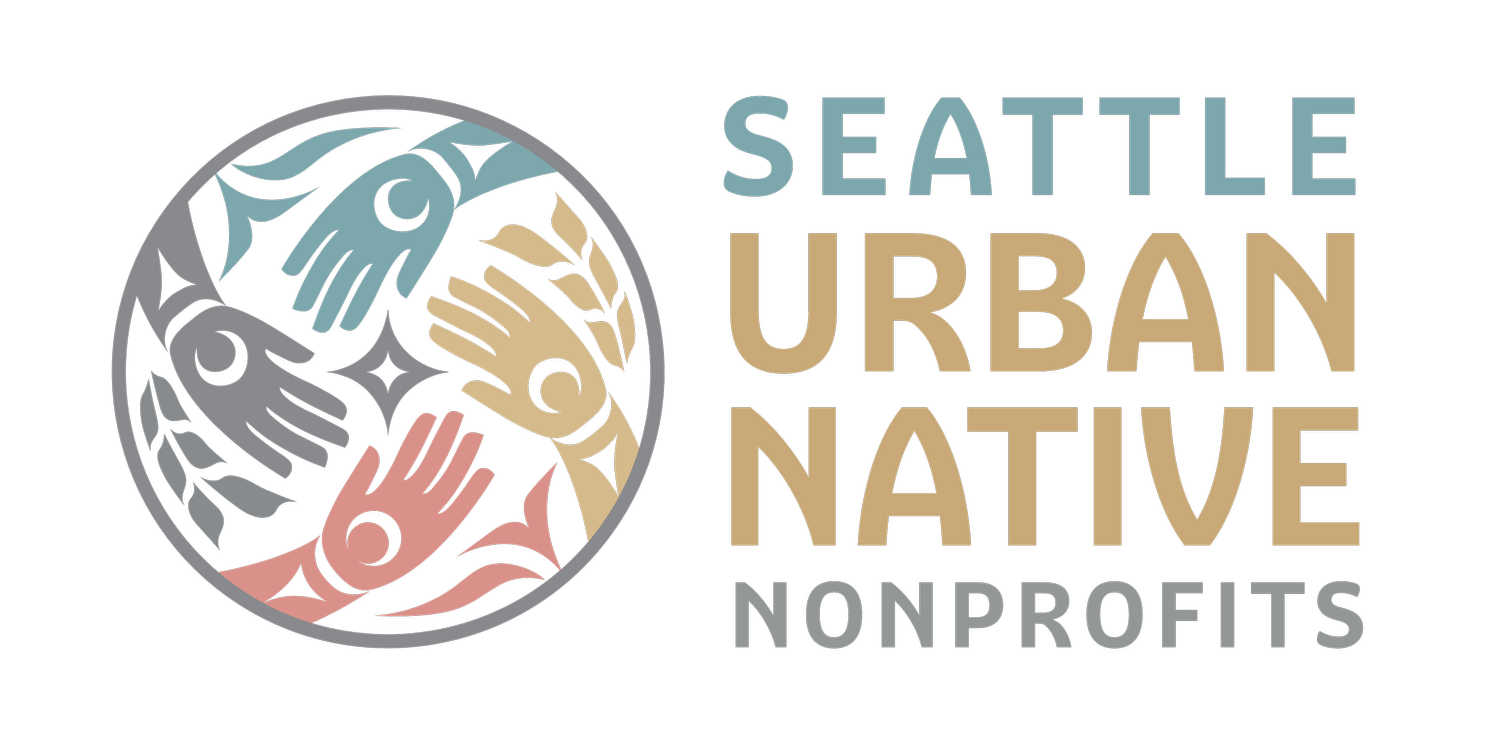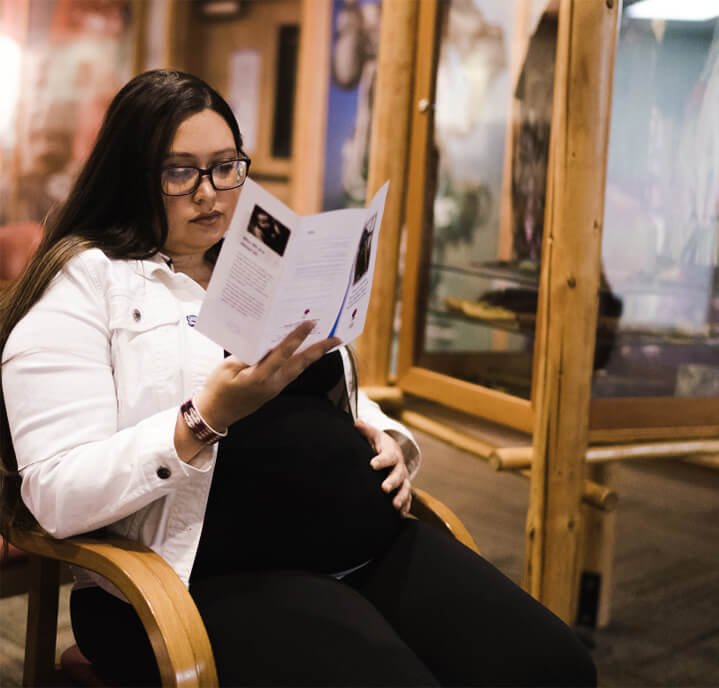OUR COMMUNITY
COMMUNITY SNAPSHOT
Seattle-King County Urban Natives
Demographics
Tribal Affiliations:
The Seattle urban Native population includes two federally recognized tribes, the Muckleshoot Indian Tribe and the Snoqualmie Tribe, but hundreds of tribes are also represented by the urban Native population. Historically, in the area now known as King County the indigenous peoples included the Duwamish, Suquamish, Nisqually, Snoqualmie, and Muckleshoot.1
Statistics:
7 out of 10 AI/AN live in urban areas[1]
Of the 1.9 million people living in King County, 39,117 or 2% identify as AI/AN alone or in combination with another race.[1]
24% of the AI/AN populations live in poverty, compared to 10.2% of the general population.[1]
The median age of the AI/AN population is 30.7 years compared to 37.1 years for the general population.[1]
2% OF POPULATION
ARE NATIVE PEOPLE
OUT OF 1.9 MILLION PEOPLE IN KING COUNTY
THE FIRST RESIDENTS
OF THIS AREA
New Era of Collective Advocacy
Native people were the first residents of the area now known as King County, and Seattle is a city that visibly celebrates its Indigenous heritage. Yet Native presence has been over the years actively resisted, obscured, ignored and even prohibited within its borders.
Today’s urban American Indian and Alaskan Natives (AI/AN) in King County grapple with a number of serious issues including:
Persistent invisibility in funding circle.
Disproportionately poor health outcomes.
Elevated rates of homelessness.
Despite these and other challenges, the Native community in and around Seattle is multicultural and vibrant, and increasingly served by Native-led nonprofit organizations providing culturally attuned services and support.
COMMUNITY
ASSETS
Nonprofit Diversity
A large and growing community of diverse Native-led nonprofits and organizations is focused on meeting the needs of the AI/AN community in King County.
Community Cohesion and Involvement
A strong cultural bond exists in the Seattle Native community, bringing together members of many tribes in a shared determination to meet needs, strengthen culture and advance traditional ways. Volunteerism is highly valued and widespread.
The 2014 United Way King County report* identified the following as Seattle-King County urban Native community’s strongest assets. These strengths still hold true today.
Hub for Native Arts and Culture
A thriving community of Native artists devoted to traditional, contemporary, and media arts is well supported by the wider community and helps keep alive distinguished art forms that remain living traditions among today’s Native families.
Native Leadership and Achievements
The Native community encompasses individuals with a wide range of professional achievements, education, and life experiences. This includes talented current leaders as well as youth leaders, who are deeply engaged with tribal and urban Native efforts.
COMMUNITY CHALLENGES
Housing
Gentrification: Due to rising income disparity and gentrification, the AI/AN population in King County is not clustered in the urban center but has moved to south, north and western sections of the county. [1]
Lack of Home Ownership: There is a much lower rate of home ownership among the AI/AN populations in King County, with only 36.8% owning their homes versus 59.9% of the general population.[1]
Homelessness: Despite representing just 2% of the population in King County, AI/AN, make up 15% of the population experiencing homelessness. [1,6]
Household Size: Rather than larger families, 1-2 person households comprise 77% of total AI/AN units served by the Seattle Housing Authority.[1]
Health
AI/AN health indicators in Washington and throughout the country are consistently lower than those of the general population.
Food Insecurity: 31% of AI/AN 6th graders in Seattle public schools lack access to breakfast, contributing to childhood hunger and community food insecurity.[2]
Health Disparities: Statistically significant disparities exist between AI/ANs and the general population in education, poverty status, unemployment, asthma, obesity, alcohol use (binge drinking), smoking, teen birth rate, infant mortality, mortality, suicide, social support, mental distress and access to healthcare.[2]
Co-Morbidity and Mortality: Urban Natives experience a disproportionate burden of disease, including chronic disease, infectious disease, and unintended injury, with extraordinarily high levels of co-morbidity and mortality.[2]
Education
Despite attempts to assimilate and erase Indigenous ways of life, tribal and urban Native communities are transforming early learning and youth and adult education systems by revitalizing Indigenous culture, traditions, and knowledge to strengthen protective factors for Indian communities and close the achievement gap.[2]
Low Preschool Attendance: Native children have lower rates of preschool attendance between the ages of three and four than their Non-Native peers.[2]
Higher Rates of Discipline: Native students in Washington are more than twice as likely to be disciplined than Non-Hispanic White students.[2]
Fewer High School Diplomas: 21.6% of Native people in King County do not have a high school diploma, compared to 5.8% of Non-Hispanic White people.[2]
31% FOOD INSECURE 6TH GRADERS LACK ACCESS TO BREAKFAST
IN THE SEATTLE PUBLIC SCHOOLS
10% OF HOMELESS ARE NATIVE IN SEATTLE KING COUNTY
NATIVE PEOPLE ARE 2% OF THE POPULATION
21.6% NO HIGH SCHOOL DIPLOMA
COMPARED TO 5.8%
OF NON-HISPANIC WHITE PEOPLE
FUNDING CHALLENGES
Native-led organizations, which play a vital role in Indigenous communities, are chronically underfunded.[3]
Chronic Underfunding: Although overall foundation giving at large steeply increased between 2006 and 2012, funds to AI/AN organizations and causes decreased by nearly a quarter in the same time period. 3 Only .23% of philanthropic funds are awarded to Native-led nonprofit organizations (NPOs), despite Native People representing 2% of the national population and are among communities of greatest need.[3]
Pieced Together Funding: Unlike federally recognized Tribes, urban Native populations do not have the government-to-government relationship with the U.S. government that allows them to make their case for assistance. Instead, they are forced to compete for discretionary funding when it’s available, piecing together local, state, federal and private resources to try to meet enormous need.[1]
JUST .23% PHILANTHROPIC
DOLLARS GO TO NATIVE CAUSES
NATIVE PEOPLE ARE 2% OF THE POPULATION
False Perceptions and Assumptions: The perception persists among funders that Native-led organizations lack the capacity to handle large investments. An interview with funders revealed these factors for this chronic underfunding:
A lack of knowledge about the history of Native People, which leads to a disconnection from Native communities.
A held the perception, common in philanthropy, that Native communities have access to federal funds and casino money, and therefore do not need philanthropic dollars
An assumption that all Native People live on reservations and thus fail to incorporate Native communities within their urban strategies.
A persistent perception that Native-led organizations lack the capacity to handle large investments.[3]
United Way of King County. 2014. Together we can lift up the sky: A Vision for the Urban Indian Community: Assessment of Assets and Opportunities for the King County Urban Indian Population. Retrieved from https://philanthropynw.org/sites/default/files/files/events/A%20Vision%20for%20the%20Urban%20Indian%20Community%20Report.pdf.
Seattle Indian Health Board. 2019. Policy Profile: Seattle Urban Native Nonprofits (SUNN) Collaborative. Internal report by Seattle Indian Health Board for SUNN.
First Nations Development Institute. July 2018. We Need to Change How We Think: Perspectives on Philanthropy’s Underfunding of Native Communities and Causes. Retrieved from https://www.firstnations.org/publications/we-need-to-change-how-we-think-perspectives-on-philanthropys-underfunding-of-native-communities-and-causes/.
United Way of King County. 2014.
Seattle Indian Health Board. 2019.
All Home. July 2020. Count Us In: Seattle/King County Point in Time Count of Persons Experiencing Homelessness. Retrieved from https://regionalhomelesssystem.org/wp-content/uploads/2020/07/Count-Us-In-2020-Final_7.29.2020.pdf.
*Together we can lift up the sky: A Vison for the Urban Indian Community: Assessment of Assets and Opportunities for the King County Urban Indian Population” can be downloaded for free at www.liftupthesky.org. The report was developed by Kauffman and Associates, Inc., with the support of the City of Seattle, Seattle Foundation, and the Muckleshoot Charity Fund. [LINK]







